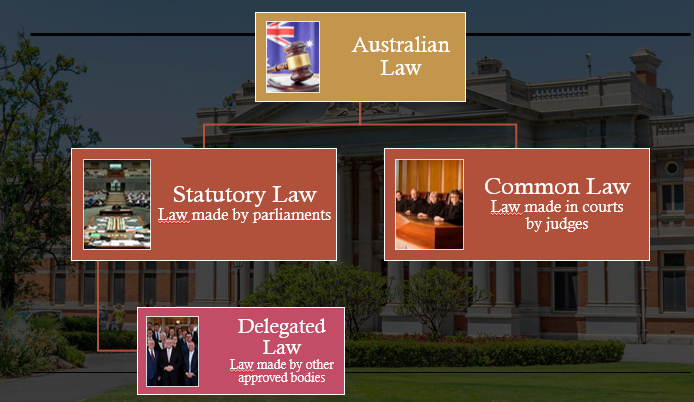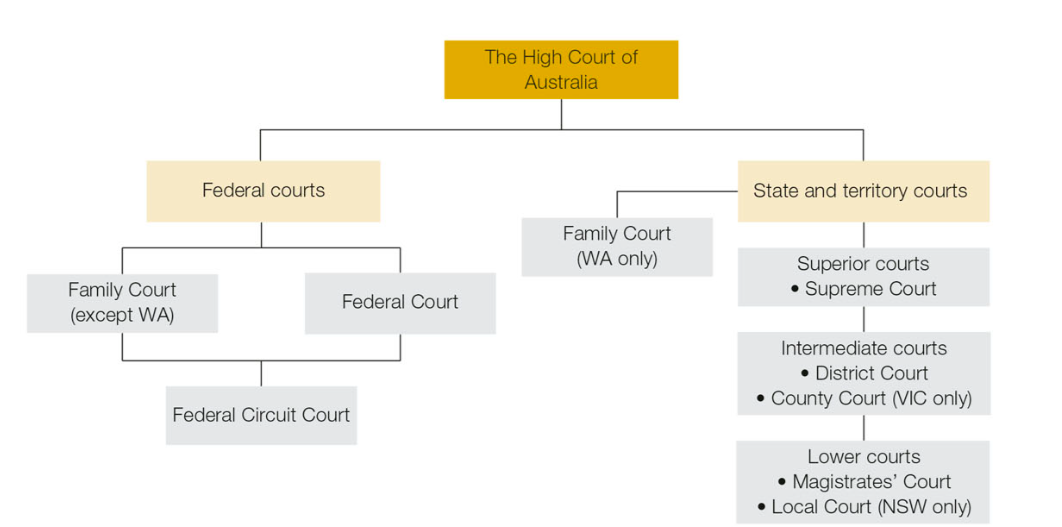HaSS - Civics and Citizenship
1/80
Earn XP
Description and Tags
shut up jonah
Name | Mastery | Learn | Test | Matching | Spaced |
|---|
No study sessions yet.
81 Terms
What is the primary role of courts (and/or the judiciary) in Australia?
To interpret and apply the law fairly and resolve disputes.
Name the highest court in Australia.
The High Court of Australia.
What is the jurisdiction of the High Court of Australia?
Interprets the Constitution, resolves disputes between states and the federal government, and hears appeals from lower courts.
What is another name for Federal court?
Commonwealth Court
What cases does the Federal Court of Australia have jurisdiction over?
Federal civil law cases like industrial relations, bankruptcy, and some criminal cases under federal law.
What cases are dealt with by State and Territory courts?
Criminal, civil, and family law matters within each state or territory.
How do courts contribute to law-making?
By using precedent, which means that past court decisions affect how future cases are decided.
What is a Magistrates' Court?
A lower-level court dealing with minor criminal and civil cases.
What is an appeal?
An appeal is a request to a higher court to review and possibly change a lower court's decision.
What is appellate jurisdiction?
The authority a higher court has to hear and decide on appeals from lower courts.
What is civil law?
Laws dealing with disputes between individuals or organizations, often involving rights, contracts, or property, rather than criminal issues.
What is statuatory law?
Laws made by parliament or legislatures and written as statutes or acts.
What is precedent?
A legal principle where courts follow previous rulings in similar cases to ensure consistency in the law.
What is common law?
The decisions of judges create precedents that must be followed in similar cases, acting as a source of law
The decisions of higher courts are binding on lower courts
When can courts create new precedents?
A case is not covered by statutory law
The meaning, interpretation or application of statutory law is unclear
What are the sections of Australian Law (include brief meaing)?
Australia Law:
Statuatory Law - Law made by parliaments
Delegated law - Law made by other approved bodies
Common Law - Law made in courts by judges

What is the role of the Federal Court of Australia
Handles civil cases governed by federal law, including bankruptcy, industrial relations, and immigration cases.
What is the jurisdiction of the Family Court of Australia?
Family law matters, including divorce, child custody, and property settlements.
What is the role of the Federal Circuit Court of Australia?
Deals with simpler cases in areas like family law, migration, and bankruptcy to reduce the load on higher courts.
What is the jurisdiction of the Supreme Court in each state and territory?
The most serious criminal cases, major civil cases, and appeals from lower state courts.
$ Range: Generally above $750,000 for civil claims.
What cases do District (or County) Courts handle?
Serious criminal cases (e.g., theft, assault) and civil cases with claims below the Supreme Court level.
$ Range: Typically up to $750,000
What is the jurisdiction of Local (or Magistrates') Courts?
Minor criminal cases, small civil disputes, and preliminary hearings for serious cases.
$ Range: Generally up to $100,000 for civil claims.
What does democracy mean?
People Power
Name 4 key features of a democratic society.
Protest, religion, movement, fair trial, free press, vote, tolerance, etc
What is direct democracy? Provide an example.
Where the people each vote on a question. Example: Referendum.
What is a representative democracy? Provide an example.
Where the people elect representatives to work on their behalf. Example: Parliament
What is the Australian Constitution?
The founding document of Australia. Sets out the key rights and responsibilities for Australian citizens
When was the constituion founded?
1901
What needs to happen in order to change the constitution?
A referendum
What is the court structure of WA?
Magistrates/Family Courts, District Court, Supreme Court, Supreme Court of Appeal
What court sees the most cases?
Magistrates court. Approx. 90-95% of all cases.
What burden of proof is needed in a criminal case?
Beyond reasonable doubt.
Discuss the court hierarchy of Australia
Magistrates/family court
District Court
Supreme Court (General Division)
Supreme Court of Appeal
High Court of Australia


Why is there a hierarchy of the court system?
Specialization: Courts focus on specific case types.
Doctrine of Precedent: Lower courts follow decisions from higher courts.
Efficiency: Minor cases handled locally; major ones by higher courts.
Right to Appeal: Cases can be reviewed by higher courts for fairness.
Who decides verdicts in different Australian courts?
High Court: Panel of 1-7 judges (no jury).
Federal and Family Courts: Judge (no jury).
Supreme Court: Judge and jury for serious criminal cases; judge alone for civil cases.
District/County Courts: Judge and jury for criminal cases; judge alone for civil cases.
Local/Magistrates' Courts: Magistrate alone (no jury).
What is criminal law?
When an individual commits an illegal act which causes harm to another or society
What is the primary purpose of criminal law?
To punish individuals who commit crimes and deter future offenses.
What is the primary purpose of civil law?
To resolve disputes between individuals or entities and provide compensation to the injured party.
How are criminal cases initiated?
By the government or state prosecuting an individual for violating laws.
How are civil cases initiated?
By individuals or entities filing a lawsuit against another party for damages or enforcement of rights.
What are the possible outcomes in a criminal case?
Conviction, acquittal, or dismissal of charges.
What are the possible outcomes in a civil case?
Monetary compensation, injunctions, or specific performance.
Civil and Criminal case similarities
Both criminal cases and civil lawsuits involve two sides:
Plaintiff (or accuser)
Defendant
Both use evidence to determine the guilt or innocence of the accused:
Testimony from witnesses
Introduction of physical evidence
Criminal and Civil case differences
Burden of Proof:
In a criminal trial:
The prosecution must prove guilt beyond a reasonable doubt.
In a civil trial:
The burden of proof lies with the plaintiff (the party filing suit).
They must prove their claim against the defendant by clear and convincing evidence.
The burden of proof has a lower threshold than in criminal court.
Purpose of the Trial:
In a criminal trial:
The purpose is to punish individuals who violate society’s laws.
In a civil trial:
The purpose is to settle disputes between individuals or private organizations.
Sentencing After a Guilty Verdict:
In a criminal trial:
A conviction may result in jail time or other punishments decided by judges within sentencing guidelines.
In a civil court:
A successful claim usually results in monetary rewards paid to the plaintiff through a settlement or court-ordered judgment.
Types of civil disputes
Family law: Disputes over births, marriages, divorces, and caregiving arrangements.
Contract law: Disputes involving agreements and contracts.
Tort over a breach of legal duty: Disputes over a violation or neglect in following one’s legal responsibilities.
Defamation: Damages to one’s reputation.
Nuisance: Interference with the enjoyment or use of one’s land.
Negligence: Failure to take proper care to prevent injury or loss.
Trespass: Interference with one’s property
What are aggravating factors?
Circumstances that increase the severity or guilt of a criminal act.
Give an example of an aggravating factor.
Repeated offence
Using a weapon during the commision of a crime
Attempted bribery
No remorse
What are mitigating factors?
Circumstances that reduce the severity or culpability of a criminal act.
Give an example of a mitigating factor.
The defendant's lack of prior criminal history.
General good character
Occassion
Attempt to avoid it
How do aggravating factors affect sentencing?
They typically lead to harsher sentences.
How do mitigating factors affect sentencing?
They can lead to lighter sentences or more lenient treatment.
Why are aggravating and mitigating factors important in legal cases?
They help the judge determine the appropriate sentence based on individual circumstances.
What is precedent?
Precedent is a previous court decision that influences future cases.
Rules vs Law
A rule is an organization’s guideline that isn’t legally enforceable, while a law is made by the government and must be followed.
Which has more authority, statute law or common law?
Statute law generally has more authority.
Can common law be changed?
Yes, common law can evolve through new court decisions.
How is common law created?
Through legal precedents established by court cases.
How is statute law created?
Through the passage of legislation by a governing body.
What is equality before the law?
Everyone is treated equally under the law, regardless of background or status.
What is an independent judiciary?
Courts operate independently from the government, ensuring fair and impartial justice.
What is the right to appeal?
The right to challenge a court's decision in a higher court if a mistake is believed to have been made.
What is bribery and corruption?
Unethical practices involving illegal payments to influence legal outcomes.
What is coercion (persuasion) of suspects and witnesses?
Pressure or threats used to force individuals to provide evidence or confessions.
What is trial by media?
Media coverage that influences public opinion and potentially affects trial fairness.
What are court delays?
- Injustice to Victims: Prolongs suffering while waiting for justice.
- Increased Legal Costs: Higher fees for all parties due to longer proceedings.
- Witness Reliability: Diminished reliability of testimony as memories fade.
- Jail Time for Defendants: Longer time in jail before trial.
- Emotional Stress: Increased stress and anxiety for all parties involved.
What is a plaintiff?
The person who brings a case to court.
What is a defendant?
The person being accused or sued in court.
What is a prosecutor?
A lawyer who represents the state in criminal cases against a defendant.
What is a respondent?
The party responding to a petition or appeal in court, often used in family law cases.
What is a judge?
A legal official who oversees court proceedings and makes rulings on legal matters.
What is a jury?
A group of citizens sworn to evaluate evidence and deliver a verdict in a trial.
What does a judge do?
Ensures the trial is fair, interprets the law, and decides on legal issues.
What does a jury do?
Listens to evidence, deliberates, and decides if the defendant is guilty or not guilty.
Who determines the sentence in a criminal case?
The judge typically determines the sentence, while the jury decides guilt.
List the 3 Key principles of Australia’s justice system
Equality before the law
Independent judiciary
Right of appeal
How can justice be undermined (case studies)?
Trial by media
Coercion of suspects & witnesses
Corruption
Court delays
What is the adversarial system?
The adversarial system is a legal process where two opposing parties present their cases to an impartial judge or jury.
What does the ‘rule of law’ mean?
The rule of law means that all individuals and institutions are accountable to the law, which is applied equally and fairly.
What is an indictment?
a formal charge or accusation of a serious crime.
What is a miscarriage of justice?
A failure in the legal process that leads to the wrongful conviction or acquittal of an individual.
What are some factors that could cause a miscarriage of justice?
Trial by media
Racial bias
Tampering with evidence
False confessions
Inadequate legal representation
Reliance on unreliable witnesses
Prosecutorial misconduct
Errors in forensic evidence
Jury bias or misunderstanding.